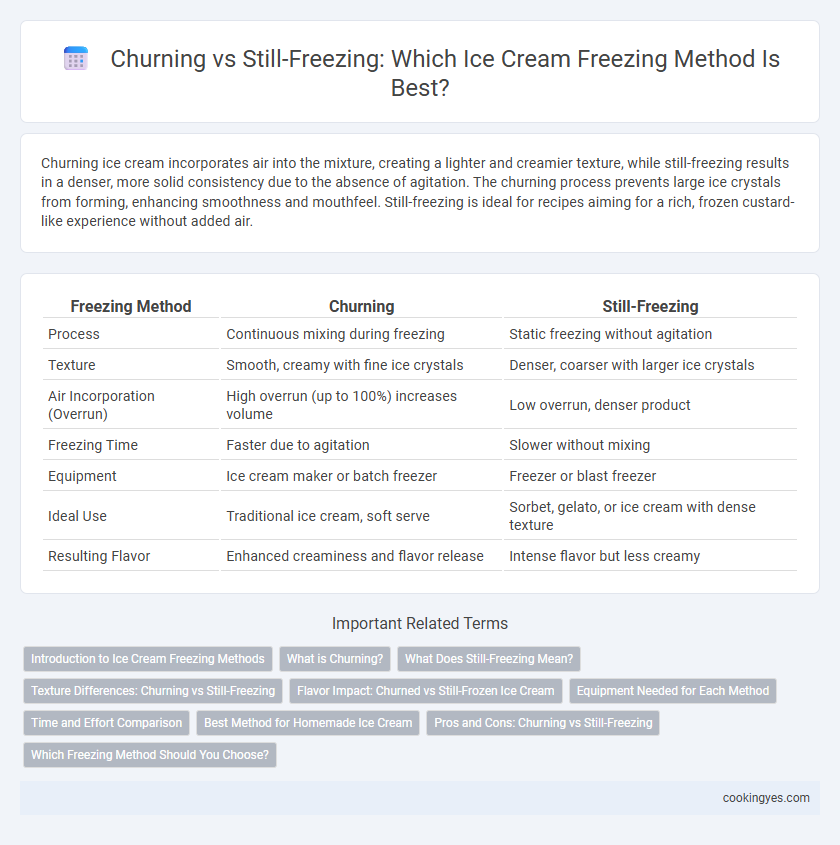Churning ice cream incorporates air into the mixture, creating a lighter and creamier texture, while still-freezing results in a denser, more solid consistency due to the absence of agitation. The churning process prevents large ice crystals from forming, enhancing smoothness and mouthfeel. Still-freezing is ideal for recipes aiming for a rich, frozen custard-like experience without added air.
Table of Comparison
| Freezing Method | Churning | Still-Freezing |
|---|---|---|
| Process | Continuous mixing during freezing | Static freezing without agitation |
| Texture | Smooth, creamy with fine ice crystals | Denser, coarser with larger ice crystals |
| Air Incorporation (Overrun) | High overrun (up to 100%) increases volume | Low overrun, denser product |
| Freezing Time | Faster due to agitation | Slower without mixing |
| Equipment | Ice cream maker or batch freezer | Freezer or blast freezer |
| Ideal Use | Traditional ice cream, soft serve | Sorbet, gelato, or ice cream with dense texture |
| Resulting Flavor | Enhanced creaminess and flavor release | Intense flavor but less creamy |
Introduction to Ice Cream Freezing Methods
Churning is a traditional ice cream freezing method that continuously stirs the mixture to incorporate air, producing a smooth texture and preventing large ice crystals. Still-freezing, also known as static freezing, involves freezing the ice cream mixture without agitation, resulting in denser, more solid ice cream with less overrun. Understanding these freezing methods is crucial for controlling ice cream texture, creaminess, and overall quality.
What is Churning?
Churning is a freezing method used in ice cream making that continuously stirs the mixture while it freezes, incorporating air and preventing large ice crystals from forming. This process ensures a smoother texture and creamier consistency by evenly distributing fat and sugar throughout the ice cream base. Compared to still-freezing, churning significantly enhances the overall mouthfeel and quality of the final product.
What Does Still-Freezing Mean?
Still-freezing is a method of freezing ice cream where the mixture solidifies without constant agitation, resulting in a denser texture compared to churning. Unlike churning, which introduces air and creates a lighter, creamier consistency, still-freezing allows ice cream to set in a more compact form. This technique is often used for artisanal or gelato styles that emphasize richness and minimal air incorporation.
Texture Differences: Churning vs Still-Freezing
Churning incorporates air into the ice cream base, creating a smooth, creamy texture with fine ice crystals, while still-freezing results in denser ice cream with larger ice crystals and a firmer consistency. The constant agitation during churning prevents ice crystal growth, enhancing the dessert's softness and mouthfeel. Conversely, still-freezing produces a more solid texture that is ideal for layered or gelato-style ice creams with intense flavor concentration.
Flavor Impact: Churned vs Still-Frozen Ice Cream
Churned ice cream incorporates air through continuous mixing, resulting in a lighter texture and enhanced flavor release that intensifies taste perception. Still-frozen ice cream, lacking air incorporation, offers a denser consistency that can mute certain flavor notes but provides a richer mouthfeel. The choice between churning and still-freezing significantly influences the sensory experience and flavor impact of the final ice cream product.
Equipment Needed for Each Method
Churning requires specialized equipment such as a hand-crank or electric ice cream maker with rotating paddles to continuously incorporate air and prevent ice crystals. Still-freezing uses a simple freezer without mechanical agitation, relying on manual stirring to achieve a creamy texture. The choice of equipment significantly affects texture and consistency in homemade ice cream production.
Time and Effort Comparison
Churning ice cream requires continuous stirring, which incorporates air and prevents large ice crystals, resulting in a smoother texture but demands active attention and typically takes 20-40 minutes. Still-freezing involves placing the mixture in a freezer without stirring, requiring minimal effort but often takes several hours and can produce a denser, icier consistency. Time efficiency favors churning for quicker results, while still-freezing suits those seeking ease with less hands-on involvement.
Best Method for Homemade Ice Cream
Churning is the best method for homemade ice cream as it continuously stirs the mixture while freezing, preventing large ice crystals and ensuring a smooth, creamy texture. Still-freezing methods, where the mixture is simply frozen without agitation, often result in icy, grainy ice cream due to uneven crystal formation. Using an electric ice cream maker or hand-crank churn provides consistent results and superior mouthfeel compared to traditional still-freeze techniques.
Pros and Cons: Churning vs Still-Freezing
Churning ice cream incorporates air, resulting in a smoother, creamier texture and faster freezing time, but it requires specialized equipment and constant motion. Still-freezing, or static freezing, uses no agitation, producing denser, icier ice cream with a longer freezing process, often favored for gelato or sorbet but lacking the lightness churning creates. Selecting between churning and still-freezing impacts texture, consistency, and equipment needs, making the choice crucial for desired ice cream quality.
Which Freezing Method Should You Choose?
Churning incorporates air into ice cream, creating a smoother, lighter texture, while still-freezing produces a denser, creamier result without added air. Choose churning if you prefer classic, fluffy ice cream with a softer bite, ideal for traditional flavors and quicker serving. Opt for still-freezing to achieve rich, intense flavors and a thick consistency, perfect for gourmet recipes or dairy-free alternatives.
Churning vs Still-Freezing for freezing method Infographic

 cookingyes.com
cookingyes.com